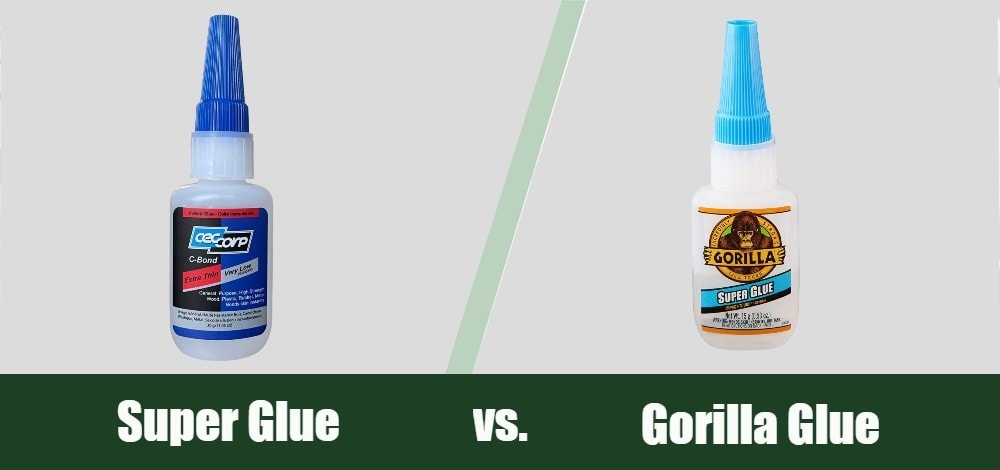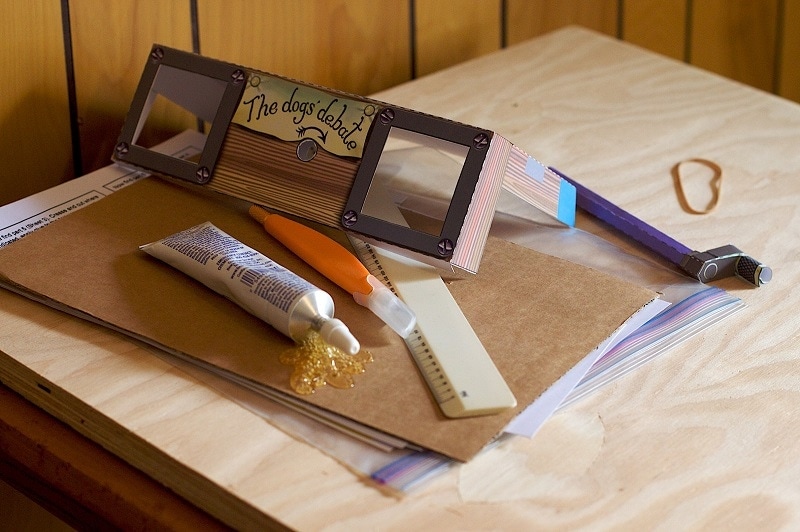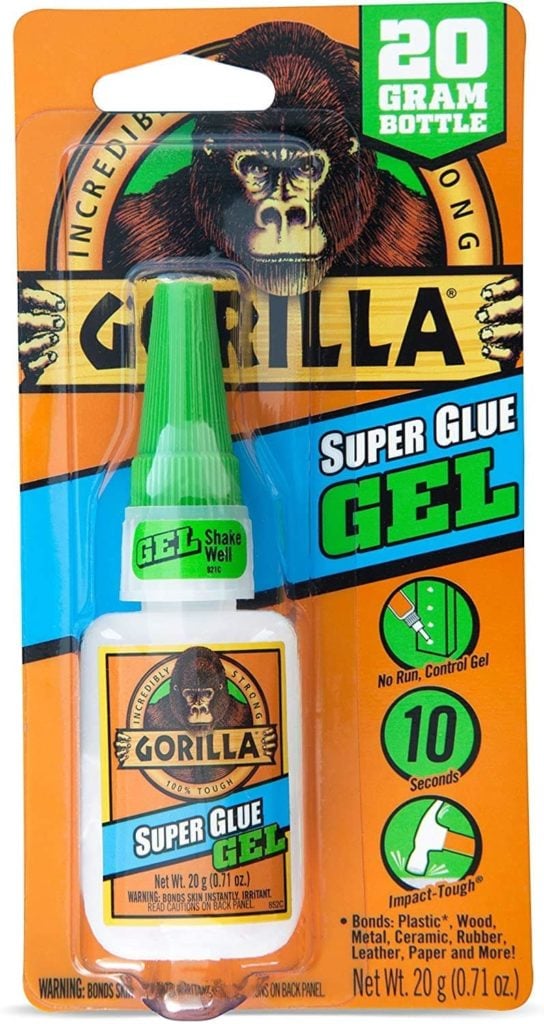Gorilla Glue vs Super Glue: Which One’s Best?
-
Pete Ortiz
- Last updated:

Gorilla Glue and Super Glue use different compounds to form an unbreakable adhesive bond between two materials. The exact origins of glue are unknown, but dye was mixed with a bonding material to ensure cave paintings adhered to rock walls, so the concept has existed since around 40,000 BC.
Great strides have been made in glue development in the past 200 years. Rubber-based glues were first used in the mid-1800s, and synthetic adhesives were developed in the 1930s before Super Glue was invented in 1958.
Gorilla Glue uses polyurethane rather than the cyanoacrylate adhesive used in Super Glue. Although they both serve the same purpose, they are pretty different in their ingredients and their intended uses. Read on to find out when to use Gorilla Glue or Super Glue and which is better for specific tasks.
Overview of Super Glue
Super Glue is a type of fast-acting, strong adhesive. It is designed to work on virtually any surface and in various conditions. The adhesive was invented in 1942 by Harry Coover, but his initial design was only used in the installation and fixing of gun sights. In 1958, when Loctite started selling its Super Glue brand, it finally reached the commercial market.

How Strong Is Super Glue?
A German manufacturing company holds the world record for producing a Super Glue capable of holding a 17-tonne truck 1 meter off the ground for 1 hour, but the glue is not commercially available since it was made especially for the record attempt.
Loctite’s Super Glue holds the world record for holding a five-ton car off the ground using nine drops of glue. This glue is available in stores and online. It should certainly be strong enough to hold the handle on your mug.
What Will It Glue?
Super Glue works quickly and forms a strong bond, but it will work on various materials, including metal, stone, ceramic, rubber, and more. While it is the most widely sold of these glues and is used around the home for several purposes, Super Glue is not effective at sticking to smooth surfaces like glass, and it will not work as well on porous surfaces like wood.
How Quickly Does It Work?
Super Glue sets within a matter of minutes. Within ten minutes, it has formed a strong bond, and for most jobs, that is enough. However, the glue does not fully set for up to 24 hours and can take longer on damp or porous surfaces. Super Glue could be your best option if you need a quick bonding action and cannot hold the workpieces together or clamp them.
What Conditions Will Super Glue Work In?
Super Glue is moisture-resistant but isn’t waterproof. It works best on dry materials. It may work on a damp surface but will take longer to cure, and the bond may not be as strong as it would be on a dry surface. Super Glue works at temperatures between 50°F and 179.6°F, so if you need an adhesive that works at more extreme temperatures, you must look elsewhere.
Techniques for the Best Performance
Try and follow these techniques for the best performance from Super Glue:
- Clean the surface, getting rid of dust and debris.
- Wipe the workpiece with a cloth to dry away moisture.
- Use only one or two drops of glue for small to medium jobs.
- Hold the pieces together for around 30 seconds.
- Colorless glue suitable for ornamental fixes
- Bonds quickly, usually in less than a minute
- Can be used on vertical surfaces
- Very strong
- The quick-sticking formula makes it difficult to adjust
- Not great for gluing wood
- The strong, noxious smell
Overview of Gorilla Glue
A variant of Gorilla Glue has been used in Indonesia for decades to repair furniture and join wood together. However, it was first introduced in the USA in 1991. Although the company now makes a host of adhesives and tapes, it is the polyurethane-based adhesive that the company remains best known for.
It is favored in woodworking and furniture projects because it works well on porous materials. While Super Glue is described as being moisture-resistant, Gorilla Glue is one of the best water-resistant adhesives on the market. It does take longer to set, may require clamps, and does not serve as wide a range of purposes as Super Glue.
How Strong Is Gorilla Glue?
While it is possible to measure Super Glue’s weight in tons, Gorilla Glue has a much more modest weight limit. It will hold up to approximately 30 pounds in weight. However, it is commonly used in woodworking and furniture projects and is not required to hold such excessive weights.
What Will It Glue?
Gorilla Glue is not a multipurpose adhesive. Its primary purpose is to repair furniture and wood. Therefore, while it will work on other materials, it should only be used on porous materials like wood.
How Quickly Does It Work?
It takes approximately 20 minutes to dry, a few hours to bond, and 24 hours to fully cure. In most cases, it requires clamps and other woodworking tools to help keep the pieces together and ensure the best possible bond between the two surfaces.
What Conditions Will Gorilla Glue Work In?
Gorilla Glue will work in more extreme temperatures than Super Glue because it does not need to form as strong a bond. Gorilla Glue will work at temperatures as low as -40°F and as high as 199.4°F. It is waterproof, but you should ensure a dry surface for the best possible initial adhesive results.
Gorilla Glue Techniques for the Best Performance
Following similar techniques to those used with Super Glue will ensure a stronger bond:
- Clean the surface to remove dust, sawdust, and debris.
- Dry the surface.
- Apply a thin layer of glue. Gorilla Glue expands up to three times, so you don’t need much.
- Clamp the workpieces together, if possible.
- Leave for 20 minutes.
- Effective on porous surfaces
- Works in extreme temperatures
- Dries a natural color
- Inexpensive
- Waterproof
- Not great on plastic
- Takes longer to bond than Super Glue
What Surfaces Are You Gluing?

Gorilla Glue and Super Glue serve different purposes and are used for different jobs. Specifically, Gorilla Glue is used for gluing wood and furniture together, usually to make repairs but also as an additional means of fixing two or more sections of a woodworking project together.
On the other hand, Super Glue does not work as well on wood or other porous surfaces because it cannot form a quick bond. Super Glue will work on plastic and ceramics and is usually ideal for small repair jobs around the house and other fixes.
Curing Time
Super Glue is usually preferred over other bonding methods because it takes little time to form a bond and stick two surfaces or materials together. It takes 10 minutes for the glue to start sticking but requires 24 hours to cure completely.
Gorilla Glue takes longer to dry, typically 20 minutes, which means that the surfaces will need clamping while it sets. Gorilla Glue also takes around 24 hours to cure fully.
Operating Temperature
Some glues lose their bond and their adhesiveness when they reach certain temperatures. Gorilla Glue may not hold as much weight, but it does operate at much higher and lower temperatures than Super Glue. Super Glue works between 50°F and 179.6°F while Gorilla Glue will work at temperatures as low as -40°F and as high as 199.4°F.
Does It Need To Be Waterproof?
Gorilla Glue is waterproof, which means that it should hold once cured, even in wet conditions. Super Glue is rated as being moisture resistant, which means that it should retain its adhesive properties when damp or moist, but it may lose integrity if it gets too wet.
Weight Resistance
When it comes down to it, the strength of the glue is one of the most critical factors. You won’t want to use any glue incapable of holding the weight that will be applied to it. This includes the weight of the workpiece and any additional weight.
If you hang a hook using Super Glue, for example, it isn’t just the weight of the hook you must consider but also the weight of whatever is hung from the hook. This shouldn’t matter with Super Glue because half a dozen drops of the adhesive can hold several tonnes, and two drops should be enough for any home project.
Gorilla Glue will hold up to 30 pounds, which should be more than enough for most furniture repairs, but you may want to take additional care if fixing the leg of a chair, for example.
- For quick bonding
- On plastic
- For freehand fixes
- For maximum weight resistance
- At extreme temperatures
- On wood
- When clamps are available
- To hold wood furniture together
Conclusion
Super Glue, Gorilla Glue, and Krazy Glue are the most popular quick adhesives on the market. They all have specific uses, and while they are similar, Gorilla Glue is more of a furniture or wood adhesive, having been made from polyurethane, while Super Glue is an all-rounder that works better on plastics, ceramics, and broken objects around the home. It is made from cyanoacrylate, bonds quickly, and will take an incredible weight, typically way beyond anything you would need from a home adhesive.
- Related Read: How to Glue Metal to Metal: Step-by-Step Guide
Contents





